Package with example models
Information
This package contains examples for the use of models that can be found in
Buildings.Electrical.AC.ThreePhasesUnbalanced.Sources.
Extends from Modelica.Icons.ExamplesPackage (Icon for packages containing runnable examples).
Package Content
| Name |
Description |
 FixedVoltageSource FixedVoltageSource
|
This example illustrates how using a fixed voltage source |
 PVPanels PVPanels
|
This example illustrates how to use PV panel models |
 PVPanels_N PVPanels_N
|
This example illustrates how to use PV panel models with neutral cable |
 WindTurbine WindTurbine
|
Example for the WindTurbine AC model |
 WindTurbine_N WindTurbine_N
|
Example for the WindTurbine AC model with neutral cable |
This example illustrates how using a fixed voltage source
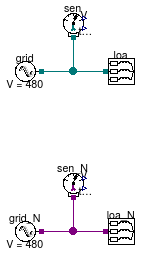
Information
This example shows how to use a fixed voltage generator model.
Extends from Modelica.Icons.Example (Icon for runnable examples).
Modelica definition
model FixedVoltageSource
"This example illustrates how using a fixed voltage source"
extends Modelica.Icons.Example;
FixedVoltage grid(
f=60,
V=480,
definiteReference=true,
phiSou=0.17453292519943)
"AC one phase electrical grid";
Sensors.ProbeWye sen(V_nominal=480)
"Probe that measures the voltage at the load";
Loads.Inductive loa(P_nominal=-2000, V_nominal=480)
"Inductive load";
FixedVoltage_N grid_N(
f=60,
V=480,
definiteReference=true,
phiSou=0.17453292519943)
"AC one phase electrical grid";
Sensors.ProbeWye_N sen_N(V_nominal=480)
"Probe that measures the voltage at the load";
Loads.Inductive_N loa_N(P_nominal=-2000, V_nominal=480)
"Inductive load";
equation
connect(grid.terminal, loa.terminal);
connect(grid.terminal, sen.term);
connect(grid_N.terminal, loa_N.terminal);
connect(grid_N.terminal, sen_N.term);
end FixedVoltageSource;
This example illustrates how to use PV panel models
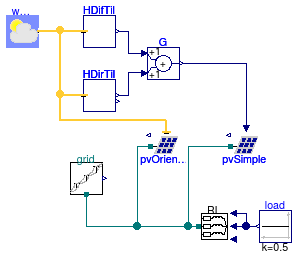
Information
This example shows how to use a simple PV model without orientation
as well as a PV model with orientation. The power produced by the PV is
partially consumed by the load, and the remaining part is fed into
the grid.
The PV produces different amounts of power on each phase according to the fractions
specified by the vector areaFraction={0.5,0.3,0.2}. In this example, 50%
of the power generation is on phase 1, 30% on phase 2 and 20% on phase 3.
Extends from Modelica.Icons.Example (Icon for runnable examples).
Modelica definition
model PVPanels
"This example illustrates how to use PV panel models"
extends Modelica.Icons.Example;
ThreePhasesUnbalanced.Loads.Inductive RL(
mode=Types.Load.VariableZ_y_input,
P_nominal=-2000,
V_nominal=480,
plugPhase3=false)
"Load taht consumes the power generted by the PVs";
ThreePhasesUnbalanced.Sources.Grid grid(f=60, V=480)
"Electrical grid model";
Modelica.Blocks.Sources.Constant load(k=0.5)
"Load consumption";
BoundaryConditions.SolarIrradiation.DiffusePerez HDifTil(
til=0.34906585039887,
lat=0.65798912800186,
azi=-0.78539816339745)
"Diffuse irradiation on tilted surface";
BoundaryConditions.SolarIrradiation.DirectTiltedSurface HDirTil(
til=0.34906585039887,
lat=0.65798912800186,
azi=-0.78539816339745)
"Direct irradiation on tilted surface";
BoundaryConditions.WeatherData.ReaderTMY3 weaDat(
computeWetBulbTemperature=false,
filNam="modelica://Buildings/Resources/weatherdata/USA_CA_San.Francisco.Intl.AP.724940_TMY3.mos");
Modelica.Blocks.Math.Add G
"Total irradiation on tilted surface";
PVsimple pvSimple( V_nominal=480,
A=100,
areaFraction={0.5,0.3,0.2})
"PV array simplified";
PVsimpleOriented pvOriented(
V_nominal=480,
A=100,
til=0.34906585039887,
lat=0.65798912800186,
azi=-0.78539816339745,
areaFraction={0.5,0.3,0.2})
"PV array oriented";
equation
connect(weaDat.weaBus,HDifTil. weaBus);
connect(weaDat.weaBus,HDirTil. weaBus);
connect(HDifTil.H,G. u1);
connect(HDirTil.H,G. u2);
connect(G.y,pvSimple. G);
connect(weaDat.weaBus, pvOriented.weaBus);
connect(load.y, RL.y2);
connect(load.y, RL.y1);
connect(grid.terminal, RL.terminal);
connect(grid.terminal, pvOriented.terminal);
connect(grid.terminal, pvSimple.terminal);
end PVPanels;
This example illustrates how to use PV panel models with neutral cable
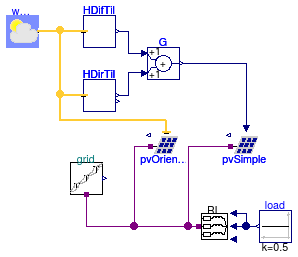
Information
This example shows how to use a simple PV model with neutral cable connection and without orientation
as well as a PV model with orientation. The power produced by the PV is
partially consumed by the load, and the remaining part is fed into
the grid.
The PV produces different amounts of power on each phase according to the fractions
specified by the vector areaFraction={0.4,0.0,0.6}. In this example, 40%
of the power generation is on phase 1, 0% on phase 2 (disconnected) and 60% on phase 3.
Extends from Modelica.Icons.Example (Icon for runnable examples).
Modelica definition
model PVPanels_N
"This example illustrates how to use PV panel models with neutral cable"
extends Modelica.Icons.Example;
ThreePhasesUnbalanced.Loads.Inductive_N RL(
mode=Types.Load.VariableZ_y_input,
P_nominal=-2000,
V_nominal=480,
plugPhase3=false)
"Load taht consumes the power generted by the PVs";
ThreePhasesUnbalanced.Sources.Grid_N grid(f=60, V=480)
"Electrical grid model";
Modelica.Blocks.Sources.Constant load(k=0.5)
"Load consumption";
BoundaryConditions.SolarIrradiation.DiffusePerez HDifTil(
til=0.34906585039887,
lat=0.65798912800186,
azi=-0.78539816339745)
"Diffuse irradiation on tilted surface";
BoundaryConditions.SolarIrradiation.DirectTiltedSurface HDirTil(
til=0.34906585039887,
lat=0.65798912800186,
azi=-0.78539816339745)
"Direct irradiation on tilted surface";
BoundaryConditions.WeatherData.ReaderTMY3 weaDat(
computeWetBulbTemperature=false,
filNam="modelica://Buildings/Resources/weatherdata/USA_CA_San.Francisco.Intl.AP.724940_TMY3.mos");
Modelica.Blocks.Math.Add G
"Total irradiation on tilted surface";
PVsimple_N pvSimple( V_nominal=480,
A=100,
plugPhase2=false,
areaFraction={0.4,0.0,0.6})
"PV array simplified";
PVsimpleOriented_N pvOriented(
V_nominal=480,
A=100,
plugPhase2=false,
til=0.34906585039887,
lat=0.65798912800186,
azi=-0.78539816339745,
areaFraction={0.4,0.0,0.6})
"PV array oriented";
equation
connect(weaDat.weaBus,HDifTil. weaBus);
connect(weaDat.weaBus,HDirTil. weaBus);
connect(HDifTil.H,G. u1);
connect(HDirTil.H,G. u2);
connect(G.y,pvSimple. G);
connect(weaDat.weaBus, pvOriented.weaBus);
connect(load.y, RL.y2);
connect(load.y, RL.y1);
connect(grid.terminal, RL.terminal);
connect(grid.terminal, pvOriented.terminal);
connect(grid.terminal, pvSimple.terminal);
end PVPanels_N;
Example for the WindTurbine AC model
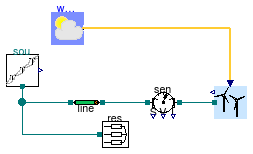
Information
This model illustrates the use of the wind turbine model,
which is connected to a AC voltage source and a resistive load.
This voltage source can represent the grid to which the
circuit is connected.
Wind data for San Francisco, CA, are used.
The turbine cut-in wind speed is 3.5 m/s,
and hence it is off in the first day when the wind speed is low.
The wind turbines produce different amounts of power on each phase according to the fractions
specified by the vector scaleFraction={0.5,0.25,0.25}. In this example, 50%
of the power generation is on phase 1, 30% on phase 2 and 20% on phase 3.
As expected the phase with the higher power production has the higher voltage deviation
from the nominal condition.
Extends from Modelica.Icons.Example (Icon for runnable examples).
Connectors
| Type | Name | Description |
|---|
| Bus | weaBus | Weather bus |
Modelica definition
model WindTurbine
"Example for the WindTurbine AC model"
extends Modelica.Icons.Example;
Buildings.Electrical.AC.ThreePhasesUnbalanced.Sources.WindTurbine tur(
table=[3.5, 0;
5.5, 100;
12, 900;
14, 1000;
25, 1000], h=10,
scale=10,
V_nominal=480,
scaleFraction={0.5,0.25,0.25})
"Wind turbine";
Buildings.BoundaryConditions.WeatherData.ReaderTMY3 weaDat(
computeWetBulbTemperature=false,
filNam="modelica://Buildings/Resources/weatherdata/USA_CA_San.Francisco.Intl.AP.724940_TMY3.mos")
"Weather data";
Buildings.BoundaryConditions.WeatherData.Bus weaBus
"Weather bus";
Loads.Resistive res(P_nominal=-500, V_nominal=480)
"Resistive line";
Grid sou(f=60, V=480)
"Voltage source";
Sensors.GeneralizedSensor sen
"Generalized sensor";
Buildings.Electrical.AC.ThreePhasesUnbalanced.Lines.Line line(
l=200,
P_nominal=5000,
V_nominal=480);
equation
connect(weaDat.weaBus,weaBus);
connect(weaBus.winSpe,tur. vWin);
connect(sou.terminal, res.terminal);
connect(sen.terminal_p, tur.terminal);
connect(sou.terminal, line.terminal_n);
connect(line.terminal_p, sen.terminal_n);
end WindTurbine;
Example for the WindTurbine AC model with neutral cable
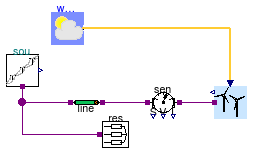
Information
This model illustrates the use of the wind turbine model with neutral cable,
which is connected to a AC voltage source and a resistive load.
This voltage source can represent the grid to which the
circuit is connected.
Wind data for San Francisco, CA, are used.
The turbine cut-in wind speed is 3.5 m/s,
and hence it is off in the first day when the wind speed is low.
The wind turbines produce different amounts of power on each phase according to the fractions
specified by the vector scaleFraction={0.4,0.0,0.6}. In this example, 40%
of the power generation is on phase 1, 0% on phase 2 (disconnected) and 60% on phase 3.
As expected the phase with the higher power production has the higher voltage deviation
from the nominal condition.
Extends from Modelica.Icons.Example (Icon for runnable examples).
Connectors
| Type | Name | Description |
|---|
| Bus | weaBus | Weather bus |
Modelica definition
model WindTurbine_N
"Example for the WindTurbine AC model with neutral cable"
extends Modelica.Icons.Example;
Buildings.Electrical.AC.ThreePhasesUnbalanced.Sources.WindTurbine_N tur(
table=[3.5, 0;
5.5, 100;
12, 900;
14, 1000;
25, 1000], h=10,
scale=10,
V_nominal=480,
plugPhase2=false,
scaleFraction={0.4,0.0,0.6})
"Wind turbine";
Buildings.BoundaryConditions.WeatherData.ReaderTMY3 weaDat(
computeWetBulbTemperature=false,
filNam="modelica://Buildings/Resources/weatherdata/USA_CA_San.Francisco.Intl.AP.724940_TMY3.mos")
"Weather data";
Buildings.BoundaryConditions.WeatherData.Bus weaBus
"Weather bus";
Loads.Resistive_N res(P_nominal=-500, V_nominal=480)
"Resistive line";
Grid_N sou(f=60, V=480)
"Voltage source";
Sensors.GeneralizedSensor_N sen
"Generalized sensor";
Buildings.Electrical.AC.ThreePhasesUnbalanced.Lines.Line_N line(
l=200,
P_nominal=5000,
V_nominal=480);
equation
connect(weaDat.weaBus,weaBus);
connect(weaBus.winSpe,tur. vWin);
connect(tur.terminal, sen.terminal_p);
connect(sen.terminal_n, line.terminal_p);
connect(line.terminal_n, sou.terminal);
connect(res.terminal, sou.terminal);
end WindTurbine_N;
Automatically generated Mon Jul 13 14:23:20 2015.


 Buildings.Electrical.AC.ThreePhasesUnbalanced.Sources.Examples.FixedVoltageSource
Buildings.Electrical.AC.ThreePhasesUnbalanced.Sources.Examples.FixedVoltageSource
 Buildings.Electrical.AC.ThreePhasesUnbalanced.Sources.Examples.PVPanels
Buildings.Electrical.AC.ThreePhasesUnbalanced.Sources.Examples.PVPanels
 Buildings.Electrical.AC.ThreePhasesUnbalanced.Sources.Examples.PVPanels_N
Buildings.Electrical.AC.ThreePhasesUnbalanced.Sources.Examples.PVPanels_N
 Buildings.Electrical.AC.ThreePhasesUnbalanced.Sources.Examples.WindTurbine
Buildings.Electrical.AC.ThreePhasesUnbalanced.Sources.Examples.WindTurbine
 Buildings.Electrical.AC.ThreePhasesUnbalanced.Sources.Examples.WindTurbine_N
Buildings.Electrical.AC.ThreePhasesUnbalanced.Sources.Examples.WindTurbine_N